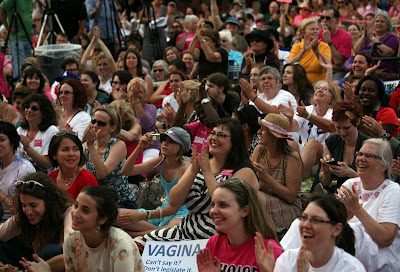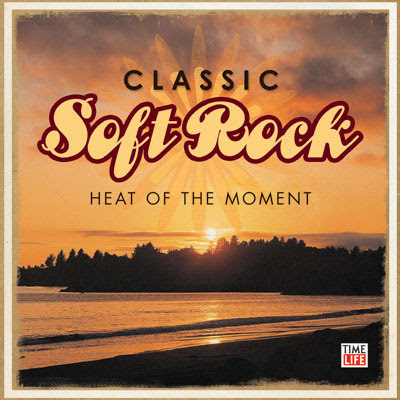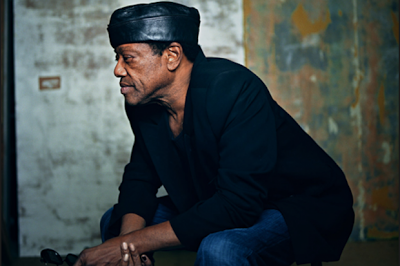Mark Anthony Neal's Blog, page 986
June 24, 2012
History Book Review: Arab Spring, Libyan Winter by Vijay Prashad
This is the summary of Arab Spring, Libyan Winter by Vijay Prashad.
Vijay Prashad is the George and Martha Kellner Chair of South Asian History, Professor and Director of International Studies at Trinity College in Hartford, CT. He is the author of a number of books, including Karma of Brown Folk (Village Voice, one of the top 25 books of the year, 2001), Everybody Was Kung Fu Fighting (Village Voice, one of the top 25 books of the year, 2002), and The Darker Nations: A People’s History of the Third World (winner of the 2009 Muzaffar Ahmad Book Prize). He writes regularly for Frontline (India) and Counterpunch (USA), and edits Bol (Pakistan) and is a contributing editor at Himal (Nepal).
Published on June 24, 2012 19:41
June 23, 2012
Saying 'Vagina' in the Pulpit

Saying 'Vagina' in the Pulpit by Reverend Wil Gafney, Ph.D. | Huffington Post
I, like many other priests, pastors and preachers am preparing to preach on the Gospel story of the woman with "an issue of blood" as I have heard it referred to euphemistically for most of my life in Mark 5:25-34 as part of the larger text assigned for July 1 this year according to the Revised Common Lectionary used by Episcopal, Lutheran, Methodist, Presbyterian and many other churches.
More recently, I have heard her ailment referred to as a hemorrhage, but I do not recall ever hearing that she had a vaginal hemorrhage. I do not believe that I have ever heard the word vagina used in the pulpit. And based on the silencing of Michigan State Representative Lisa Brown after -- and many would argue because -- she used the word vagina in her remarks opposing further restrictions on abortions designed to prevent women from accessing health care when they determine they need it and choosing to terminate pregnancies, all of which is legal, I think it is time to talk about vaginas in the scriptures, in the church and in and from the pulpit.
First of all, it needs to be said that vagina is an anatomical, medical term, like arm, leg and prostate, all of which occur in our public discourse without censure. The attempt to codify the word vagina as unfit for mixed company reflects the equating of women with vaginas -- when women's (and men's) bodies come in many configurations -- and the devaluing of women as full participants in society, demonstrated recently by the rash of legislation pertaining to women's health care, bodies and vaginas: laws requiring medical personnel to insert ultrasound probes into women's vaginas without their consent or medical necessity determined by a health care professional; proposed legislation giving employers the right to deny birth control to women, leading to discussions about women giving men repeated, unfettered access to their vaginas making them sluts. Add all of this to the recent silencing of Rep. Brown (and MI State Rep. Barb Bynum after she used the word vasectomy).
One response to the silencing of Reps. Brown and Bynum was a performance of Eve Ensler's play The Vagina Monologues on the steps of the Michigan State House. That performance was a contemporary example of a prophetic response to an injustice. Biblical prophets were poets and performance artists. And their language was regularly graphic and shocking: Ezekiel speaks of the rape of menstruating women (22:10), Ezekiel also speaks of Jerusalem as a woman being handed over by God to men who will strip, beat, stone and cut her to pieces (chapters 18, 23); Hosea speaks of the skulls of babies being crushed and pregnant women having their wombs ripped open (Hos 16:33); Jeremiah accuses God of overpowering him using a verb that means rape in other contexts, (Jeremiah 20:7, see also 2 Samuel 13:14).
And into the tradition of the Israelite prophets Jesus of Nazareth was born to a woman in what classical Christian theology calls the scandal of the Incarnation. I once heard Cornel West say that the scandal is that Jesus emerged from a woman's body in intimate proximity to urine and feces. Using those medically appropriate terms, like specifying that Jesus emerged from the vagina and not just the womb of the Virgin Mary, would probably be shocking to many contemporary congregations, yet neither the claims nor the language would be shocking in the world(s) of the scriptures: King Rehoboam's advisors tell him to say that his little finger is thicker than his father's penis (most translators choose the word "loins" in Two Kings 12:10). And while the Church would eventually seek to limit the participation of women in religious and public life in the name of Jesus, it would do so disregarding the Judaism he practiced and modeled. (Patriarchy and the subordination of women is neither endemic nor unique to first century Judaism -- of which there were many varieties.)
And so I turn to the story in the Gospel of Mark in which a woman bleeding profusely from her vagina touched the tzit-tzit fringe on Jesus' clothes -- that symbol of observant Judaism that endures to the present day. She takes it upon herself to effect her own healing, believing that touching the clothes of Jesus would make her well. And it did. His response to affirm her healing and her agency in securing her own healing -- "Daughter, your faith has made you well; go in peace, and be healed of your disease" -- does not treat her or her vaginal hemorrhage as any different from any other ailment he heals.
In the aftermath of the silencing of Rep. Brown, I confess that I took some delight in the many tweeple who took to the twitterverse to speculate on what if any euphemistic term would have been acceptable in lieu of the medically appropriate anatomical term, vagina. And I affirmed the sentiment in and reposted the Facebook meme saying that people [men] who could not say "vagina" should not legislate about them. But beyond the hashtag still lies the question of whether women can be seen as full human beings when our very biology remains unmentionable.
Lastly, the representative's point in her remarks before her censure that her Judaism permits and even calls for abortion in some cases to save the life of the mother was overlooked in much of the debate about her use of the word "vagina." It is an important point about religious freedom. She insists as is her right under the United States Constitution to the free exercise of religion without having anyone else constrict her religious practice by say, denying her or her daughter access to legal medical services because of their religious beliefs.
And finally (I know I said "lastly" above but you can count on many black preachers to add one more point after "lastly") hear the word of the Lord through the urban hip-hop prophet 2Pac Shakur:
And since we all came from a woman
Got our name from a woman and our game from a woman
I wonder why we take from our women
Why we rape our women, do we hate our women?
... Keep ya head up. *** Wil Gafney, Ph.D. is Associate Professor of Hebrew and Old Testament at the Lutheran Theological Seminary at Philadelphia in Pennsylvania and is an Episcopal Priest canonically resident in the Diocese of Pennsylvania. She is also a member of the Dorshei Derekh Reconstructionist Minyan of the Germantown Jewish Center in Philadelphia PA. In addition she has co-taught courses with and for the Reconstructionist Rabbinical Seminary in Wyncote, PA.
Published on June 23, 2012 16:26
A Black Music Month Tribute to Soft Rock

A Black Music Month Tribute to Soft Rock by Mark Anthony Neal | NewBlackMan
For much of my childhood, I lived an undercover life. Growing up in the Bronx and amongst my friends, I was, for the most part, a normal nappy-headed Negro—that is until I retreated into the safety of my bedroom and my transistor radio, and listened to stations like WAMC-AM, WCBS-FM and WXLO—99X (in the years before 98.7 Kiss). It is in those moments that I fell in loft with Soft Rock—a secret I was able to keep, until I was exposed one day, after a trip to the record store and some of my friends discovered the copy of Andy Gibbs’ “Shadow Dancing” in my bag and followed with the quip, “you listen to that shit.”
Indeed there were many afternoons, holed up in my room, listening to Harry Harrison or Dan Ingram on WABC, while playing dozens of games of Strat-o-Matic Baseball. Even today, it not unusual during long drives with the family, to put on my playlist “Harry Harrison” (recently renamed “Chuck Leonard” to acknowledge the late Black jock who broke through on Pop-Top 40 radio, before beginning a long career and 98.7-Kiss-FM), much to the dismay of my family, especially when I break out in-sing-along with Paul McCartney on Wings’ “With a Little Luck.”
Below is my small “Black Music Month” tribute to Soft Rock.
Todd Rundgren—“I Saw the Light” (1972)
Came to appreciate Rundgren’s songwriting as an adult, listening to the Isley’s version of his “Hello It’s Me,” (they also covered Seals and Crofts’s “Summer Breeze”) but it’s “I Saw the Light” that finds me hitting the repeat button—often. Something about that feeling of a new relationship and that sense of whimsy and surprise in his vocals.
England Dan and John Ford Coley—“Love is the Answer” (1979)
The duo is most well known for the track “I’d Really Love to See You Tonight”—which I didn’t like. I always managed to catch “Love is the Answer” in the middle, right before the Gospel choir breaks out in song. For years I thought it was Cliff Richards, until a successful Google search a few years ago directed me to England Dan and Coley (both from Texas, incidentally). Turns out there was a Rundgren connection; song was written by Rundgren and originally recorded by his group Utopia in 1977.
Ambrosia—“How Much I Feel” (1978)
The year was 1978 and I was in 8th grade, experiencing my first real romantic relationship (if you could call it that at age 12). Was in the midst of an afternoon nap when I first heard Ambrosia’s “How Much I Feel” and immediately loved the story that the group was telling, about the ups and downs of a relationship. The post-breakup third verse has always stayed with me: “how’s your life been going on? | I got a wife now, for years we been going strong…”—a line I have imagined saying to any number of my ex-girlfriends. With songs like “The Biggest Part of Me” (later covered by Take 6) and “You’re the Only Woman,” Ambrosia remains one of my favorite pop groups from that era.
Bee Gees—“Fanny (Be Tender with My Heart)” (1976
I was never a big fan of the Bee Gees, but after Saturday Night Fever (1977), I absolutely hated them. Give the Brothers Gibb some credit—they could write some songs. Folk often forget that Al Green was covering them, on his classic “How Can You Mend a Broken Heart.” “Fanny” was the third single from their first Gold album Main Course (1975) which also included “Nights on Broadway” and “Jive Talkin,’” the latter signaling their entry into Disco.
Boz Scaggs—“Lowdown” (1976)
So for the record, Boz Scaggs shouldn’t be on this list; he’s the only White artist from the 1970s (save Elton John or David Bowie) that I would have heard on both WABC and WBLS in New York. “Lowdown” was quintessential 1970s Pop radio, taken from his breakthrough Silk Degrees. When I later heard “Lido Shuffle” on 99X, I was surprised to find out that it was from the same artist. But Scaggs wasn’t just slumming on Soul street, as a track like “JoJo” (1980) later showed.
Rickie Lee Jones—“Chuck E’s in Love” (1979)
While my parents listened to Black radio in the 1970s, namely WBLS, and I was trolling on AM Top-Pop-40, I was largely obvious to FM rock stations, of which 99X was one of the most prominent in New York. The introduction came courtesy of my bestie Frank Paul, whose older sister Stacy was a fan of the station. With access to groups like Queen, ELO and Steeley Dan, my musical palate was immediately expanded. It was in that same Paul household where I was introduced to Rickie Lee Jones’ “Chuck E’s in Love,” and Jones bluesy' slur of a voice (clearly influenced by Billie Holiday, though I was oblivious to that in 1979). Returned to Jones’ self-titled debut years later when Jazz vocalist Dianne Reeves covered her “Company.”
Andy Gibb and Olivia Newton John—“I Can’t Help It” (1981)
As I mentioned in the intro, had a bit of a thing for Andy Gibb’s music when I was young. Bought singles from both of his first two albums with “I Just Want to Be Your Everything” (1977) and “Everlasting Love” (1979) being particularly favorites. My favorite Gibb song though is from his last studio album—as his career would be derailed by drug addition until his death at age 30 in 1988. “I Can’t Help It,” paired Gibb with friend Olivia Newton John—the Brothers Gibb, Newton John, and Air Supply (the group that practically defined Soft Rock) were all part of an Australian music invasion. There was a sweetness about “I Can’t Help It” that I recognized even as a 15-year-old—a sweetness that I return to fairly regularly on my iPod.
Dave Mason—“We Just Disagree” (1977)
The joy on the MP3 era is that if you liked a song, you could just download that song—and such was the case with Dave Mason’s “We Just Disagree.” I don’t know any other Mason songs, except “Feelin’ Alright,” a song he wrote while with the band Traffic and was later recorded by Joe Cocker. Given the era it was released, I always thought the song was a post-1960s remembrance of that time—two friends, one who might have gone to Vietnam, another, who left for Canada, reconnecting; turns out it’s a song about divorce. Go figure.
Motherlode—“When I Die” (1969)
“When I Die” was a song that I recall hearing on three separate occasions between 1983 and 1997. First heard it during one of WCBS-FM’s weekly top-20 countdowns from the past—1969—and of course I didn’t get the name of the song or the band, but the song just affected me. Heard it again on two occasions while living in the Buffalo area in the 1990s, which I would later find out made some sense, since the band was from just across the border in Ontario and got a lot of airplay in places like Buffalo and Detroit (more on that in a bit) during their heyday. Enough of the melody and lyrics had stayed with me, that when I heard the song in the car of my colleague, Northwestern political scientist Richard Iton, I gasped for air, figuring that my long search was over (which it was). Iton, who had roots in the Caribbean and Ontario, was aware of the song from his youth, but had taken an additional interest in the song because of a now celebrated Detroit producer—James Yancy—who sampled the song (on his deathbed) for “Welcome to the Show” (Donuts). And yes, one of them is Black.
Published on June 23, 2012 05:54
June 22, 2012
Black Folk Don't: Know Downton Abbey
NBPC Is the Downton Abbey craze making it to black folk? Is it public television? This video was created as part of the National Association of Black Journalists 2012 Conference, for a panel discussion about more representation for black content on public television.
Published on June 22, 2012 19:09
Soul Man Revived: Bobby Womack’s The Bravest Man in the Universe

Soul Man Revived: Bobby Womack’s The Bravest Man in the Universe by Mark Anthony Neal | Ebony.com
“As a singer grows older, his conception goes a little bit deeper, because he lives life and he understands what he is trying to say a little more”—Smokey Robinson
The above quote from William “Smokey” Robinson, a fifty-plus year veteran of the music industry, could have been directed at any number of his still contemporaries, such as Al Green or Ronald Isley. Green’s psychic and spiritual conversion over a pot of grits (and a suicide) and Isley’s recent tax conviction are well known to the public. Bobby Womack’s story is less well- known, thus it is fitting that Robinson’s quote is heard on Womack’s new recording The Bravest Man in the Universe—his first studio recording in twelve years.
For the uninitiated, Bobby Womack was born in Cleveland, OH in 1944, and first came to prominence as a teen recording with his brothers as The Valentino’s. The group caught the attention of Soul legend Sam Cooke, who managed and mentored the group, and encouraged Womack to allow The Rolling Stones to record his song, “It’s All Over Now,” which became the group’s first number one record in the UK.
Cooke and Womack developed a particularly close friendship, which is perhaps why Womack, thought it was logical to marry Cooke’s widow, Barbara Campbell, only months after the singer’s murder in December of 1964. The couple only waited that long, because Womack was still too young to get married without a parent’s permission. Womack publicly hints at the relationship on his 1985 track “I Wish He Didn’t Trust Me So Much,” which is about a man who falls in love with his best friend’s wife.
Womack and Campbell shared a tumultuous relationship for five years, including an affair with Campbell’s daughter Linda (his step-daughter), that Womack documents in his memoir Midnight Mover: The True Story of the Greatest Soul Singer in the World. The relationship ended when Campbell shot Womack. Womack’s only son with Campbell, committed suicide in the mid-1980s, an infant son he had with his second wife died a crib death, and a third son is incarcerated for second-degree murder. Add to the mix, his struggles with drug addition, and his recent bout with a benign tumor in his colon and pneumonia, and Bobby Womack’s life seems like a reality show in the making.
Read More at Ebony.com [image error]
Published on June 22, 2012 18:35
The BGR Show: Review of the MacBook Pro Retina
iamOTHER
Like the iPhone 4S did for smart phones and the new iPad did for tablets, the new MacBook Pro with Retina display changes the way people will look at computers - literally. Plus, Jay Sean is obsessed with his crazy iPhone photo app, Juxtaposer.
Published on June 22, 2012 18:24
Open Line News with Davey D (episode 3)
Host Davey D is joined by H. Samy Alim (Stanford) and Mark Gonzalez
Published on June 22, 2012 08:54
June 21, 2012
What’s Killing Our Culture? It’s Not the Mainstream and Tight Jeans

What’s Killing Our Culture? It’s Not the Mainstream and Tight Jeansby Adia “Dr. Dia” Winfrey, Psy.D. | special to NewBlackMan
Hip Hop’s current fashion trends and “the mainstream” are not killing our culture. Despite popular belief, “the mainstream” is not and has never been the enemy of Hip Hop culture. Unlike our now clichéd recollection of its birth, Hip Hop culture was not made popular because it went against the mainstream. To the contrary, the culture became a movement, because it allowed marginalized groups to claim mainstream spaces. Hip Hop culture was born of Black and Latino youth who did not veer too far from behaviors exhibited by all teens and pre-teens. They embraced music and fashion that highlighted their uniqueness.
The difference between Hip Hop’s architects, and “mainstream” youth was their audacity to demand and claim their space using the limited means at their disposal. In generations past, Hip Hop’s architects would have been teens attending sock hops or juke joint parties, as opposed to park dwellers using street lights to power booming sound systems. But like many double standards still in place today, Black and Brown youth are held to criterion their white counterparts aren’t, and demonized for engaging in similar behavior. We see it in the criticisms of popular or “mainstream” Hip Hop culture, and the Black youth who embrace it.
While it’s been known for decades the primary purchasers of rap music (Hip Hop culture’s most popular element) are white, it is Black youth that are seen as the victims and destroyers of Hip Hop culture from music to fashion. Many adults whom I refer to as “Hip Hop elitists,” persistently criticize Black youth for wearing popular, trending fashion. Whether it was mini-skirts, bell bottoms, or Hammer pants, youth have never sought fashion approval from adults. And like gazelles and polka dots, this too shall pass…and likely return again. But clothing has little to do with our ailing culture and struggling communities. Even if every teenager in America wore tailor-made pants above their wastes, we’d still be in trouble.
The aim of our concern shouldn’t be on fashion, but our youth’s lost voices. The genius of Hip Hop culture lies in the power of those youth who demanded to be seen and heard. Yes, social consciousness in public figures is admirable, but is not more powerful than the voices of our youth. Holding “the mainstream” accountable for the apathy within Hip Hop culture is equally as futile, only creating abstract enemies while relinquishing our power. It’s time to take lessons from the youth who are Hip Hop’s architects and strategize.
Instead of touting Hip Hop culture’s rage against the mainstream, let’s use mainstream resources and old-school tactics to initiate action that will empower our communities. Rather than nostalgic reminiscing sessions about the Golden Era of Hip Hop in comparison to the culture today, let’s use our connection to the culture to connect with our youth. Lest we forget Tupac and NWA, Hip Hop legends today, were initially viewed as liabilities to the culture. We see what is happening to us. Waiting for artists to spark a movement or youth fashion to change only ensures our slow death continues. It is our individual and collective responsibilities to revitalize Hip Hop culture and our communities. Now’s the time…let’s get HYPE!
***
Adia “Dr. Dia” Winfrey, Psy.D, is the author of H.Y.P.E.: Healing Young People thru Empowerment (African-American Images, 2009) and has been featured on NPR, in JET Magazine, and endorsed by syndicated radio personalities Tom Joyner and Michael Baisden. Learn more at letsgethype.com.
Published on June 21, 2012 12:48
Mark Anthony Neal's Blog
- Mark Anthony Neal's profile
- 30 followers
Mark Anthony Neal isn't a Goodreads Author
(yet),
but they
do have a blog,
so here are some recent posts imported from
their feed.



